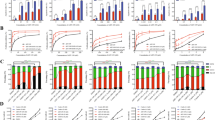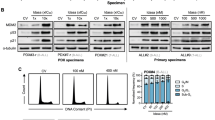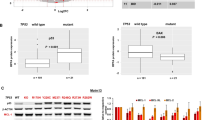Abstract
In chronic lymphocytic leukaemia (CLL), mutation/deletion of TP53 is strongly associated with early disease progression, resistance to chemotherapy and short patient survival. Consequently, there is a pressing need to develop novel treatment protocols for this high-risk patient group. The present study was performed to evaluate Hsp90 inhibition as a possible therapeutic approach for such patients. Primary CLL cells of defined ataxia telangiectasia mutated (ATM)/p53 status were incubated with the Hsp90 inhibitor geldanamycin (GA) and analysed by western blotting for the expression of p53, p21, MDM2 and Akt. GA downregulated overexpressed mutant p53 protein (an oncogene) and upregulated wild-type (wt) p53 (a tumour suppressor). The upregulation of wt p53 by GA was independent of ATM and was accompanied by downregulation of Akt and the active form of MDM2, indicating a possible mechanism. GA also produced a p53/ATM-independent increase in the levels of p21—a potent inducer of cell-cycle arrest. In-vitro cytotoxicity studies showed that GA killed cultured CLL cells in a dose- and time-dependent fashion irrespective of their p53/ATM status and more effectively than normal blood mononuclear cells. In summary, our findings reveal important consequences of inhibiting Hsp90 in CLL cells and strongly support the therapeutic evaluation of Hsp90 inhibitors in poor-prognosis patients with p53 defects.
This is a preview of subscription content, access via your institution
Access options
Subscribe to this journal
Receive 50 print issues and online access
$259.00 per year
only $5.18 per issue
Buy this article
- Purchase on Springer Link
- Instant access to full article PDF
Prices may be subject to local taxes which are calculated during checkout





Similar content being viewed by others
References
Bartek J, Bartkova J, Vojtesek B, Staskova Z, Lukas J, Rejthar A et al. (1991). Aberrant expression of the p53 oncoprotein is a common feature of a wide spectrum of human malignancies. Oncogene 6: 1699–1703.
Basso AD, Solit DB, Chiosis G, Giri B, Tsichlis P, Rosen N . (2002). Akt forms an intracellular complex with heat shock protein 90 (Hsp90) and Cdc37 and is destabilized by inhibitors of Hsp90 function. J Biol Chem 277: 39858–39866.
Bernstein C, Bernstein H, Payne CM, Garewal H . (2002). DNA repair/pro-apoptotic dual-role proteins in five major DNA repair pathways: fail-safe protection against carcinogenesis. Mutat Res 511: 145–178.
Blagosklonny MV, Toretsky J, Bohen S, Neckers L . (1996). Mutant conformation of p53 translated in vitro or in vivo requires functional HSP90. Proc Natl Acad Sci USA 93: 8379–8383.
Blandino G, Levine AJ, Oren M . (1999). Mutant p53 gain of function: differential effects of different p53 mutants on resistance of cultured cells to chemotherapy. Oncogene 18: 477–485.
Cadwell C, Zambetti GP . (2001). The effects of wild-type p53 tumor suppressor activity and mutant p53 gain-of-function on cell growth. Gene 277: 15–30.
Carter A, Lin K, Sherrington PD, Atherton M, Pearson K, Douglas A et al. (2006). Imperfect correlation between p53 dysfunction and deletion of TP53 and ATM in chronic lymphocytic leukaemia. Leukemia 20: 737–740.
Castro JE, Prada CE, Loria O, Kamal A, Chen L, Burrows FJ et al. (2005). ZAP-70 is a novel conditional heat shock protein 90 (Hsp90) client: inhibition of Hsp90 leads to ZAP-70 degradation, apoptosis, and impaired signaling in chronic lymphocytic leukemia. Blood 106: 2506–2512.
Catovsky D, Richards S, Matutes E, Burford A, Brito-Babapulle V, Dearden C et al. (2004). Response to therapy and survival in CLL is influenced by genetic markers. Preliminary analysis from the LRF CLL4 trial. Blood 104: 13.
Chen H, Treweeke AT, West DC, Till KJ, Cawley JC, Zuzel M et al. (2000). In vitro and in vivo production of vascular endothelial growth factor by chronic lymphocytic leukemia cells. Blood 96: 3181–3187.
Chiorazzi N, Rai K, Ferrarini M . (2005). Chronic lymphocytic leukemia. N Engl J Med 352: 804–815.
Choi HJ, Chung TW, Kang SK, Lee YC, Ko JH, Kim JG et al. (2006). Ganglioside GM3 modulates tumor suppressor PTEN-mediated cell cycle progression—transcriptional induction of p21(WAF1) and p27(kip1) by inhibition of PI-3K/AKT pathway. Glycobiology 16: 573–583.
Clarke AR, Purdie CA, Harrison DJ, Morris RG, Bird CC, Hooper ML et al. (1993). Thymocyte apoptosis induced by p53-dependent and independent pathways. Nature 362: 849–852.
Cordone I, Masi S, Mauro FR, Soddu S, Morsilli O, Valentini T et al. (1998). p53 expression in B-cell chronic lymphocytic leukemia: a marker of disease progression and poor prognosis. Blood 91: 4342–4349.
Crespo M, Bosch F, Villamor N, Bellosillo B, Colomer D, Rozman M et al. (2003). ZAP-70 expression as a surrogate for immunoglobulin-variable-region mutations in chronic lymphocytic leukemia. N Engl J Med 348: 1764–1775.
Damle RN, Wasil T, Fais F, Ghiotto F, Valetto A, Allen SL et al. (1999). Ig V gene mutation status and CD38 expression as novel prognostic indicators in chronic lymphocytic leukemia. Blood 94: 1840–1847.
Dittmer D, Pati S, Zambetti G, Chu S, Teresky AK, Moore M et al. (1993). Gain of function mutations in p53. Nat Genet 4: 42–46.
Dohner H, Fischer K, Bentz M, Hansen K, Benner A, Cabot G et al. (1995). p53 gene deletion predicts for poor survival and non-response to therapy with purine analogs in chronic B-cell leukemias. Blood 85: 1580–1589.
Dohner H, Stilgenbauer S, Benner A, Leupolt E, Krober A, Bullinger L et al. (2000). Genomic aberrations and survival in chronic lymphocytic leukemia. N Engl J Med 343: 1910–1916.
el Rouby S, Thomas A, Costin D, Rosenberg CR, Potmesil M, Silber R et al. (1993). p53 gene mutation in B-cell chronic lymphocytic leukemia is associated with drug resistance and is independent of MDR1/MDR3 gene expression. Blood 82: 3452–3459.
Feng J, Tamaskovic R, Yang Z, Brazil DP, Merlo A, Hess D et al. (2004). Stabilization of Mdm2 via decreased ubiquitination is mediated by protein kinase B/Akt-dependent phosphorylation. J Biol Chem 279: 35510–35517.
Fujita N, Sato S, Ishida A, Tsuruo T . (2002). Involvement of Hsp90 in signaling and stability of 3-phosphoinositide-dependent kinase-1. J Biol Chem 277: 10346–10353.
Gine E, Bosch F, Ferrer A, Villamor N, Abella MA, Gardella S et al. (2005). Fludarabine, cycloophosphamide and mitoxantrone (FCM) induces a high response rate in previously untreated CLL. Leuk Lymphoma 46 (Suppl 1): S89.
Hainaut P, Hollstein M . (2000). p53 and human cancer: the first ten thousand mutations. Adv Cancer Res 77: 81–137.
Hamblin TJ, Davis Z, Gardiner A, Oscier DG, Stevenson FK . (1999). Unmutated Ig V(H) genes are associated with a more aggressive form of chronic lymphocytic leukemia. Blood 94: 1848–1854.
Harvey M, Vogel H, Morris D, Bradley A, Bernstein A, Donehower LA . (1995). A mutant p53 transgene accelerates tumour development in heterozygous but not nullizygous p53-deficient mice. Nat Genet 9: 305–311.
Iggo R, Gatter K, Bartek J, Lane D, Harris AL . (1990). Increased expression of mutant forms of p53 oncogene in primary lung cancer. Lancet 335: 675–679.
Jascur T, Brickner H, Salles-Passador I, Barbier V, El Khissiin A, Smith B et al. (2005). Regulation of p21(WAF1/CIP1) stability by WISp39, a Hsp90 binding TPR protein. Mol Cell 17: 237–249.
Jones DT, Addison E, North JM, Lowdell MW, Hoffbrand AV, Mehta AB et al. (2004a). Geldanamycin and herbimycin A induce apoptotic killing of B chronic lymphocytic leukemia cells and augment the cells' sensitivity to cytotoxic drugs. Blood 103: 1855–1861.
Jones DT, Ganeshaguru K, Anderson RJ, Jackson TR, Bruckdorfer KR, Low SY et al. (2003). Albumin activates the AKT signaling pathway and protects B-chronic lymphocytic leukemia cells from chlorambucil- and radiation-induced apoptosis. Blood 101: 3174–3180.
Jones GG, Reaper PM, Pettitt AR, Sherrington PD . (2004b). The ATR-p53 pathway is suppressed in noncycling normal and malignant lymphocytes. Oncogene 23: 1911–1921.
Kamat CD, Green DE, Warnke L, Thorpe JE, Ceriello A, Ihnat MA . (2007). Mutant p53 facilitates pro-angiogenic, hyperproliferative phenotype in response to chronic relative hypoxia. Cancer Lett 249: 209–219.
Kieser A, Weich HA, Brandner G, Marme D, Kolch W . (1994). Mutant p53 potentiates protein kinase C induction of vascular endothelial growth factor expression. Oncogene 9: 963–969.
Kim E, Deppert W . (2004). Transcriptional activities of mutant p53: when mutations are more than a loss. J Cell Biochem 93: 878–886.
Lane DP . (1992). Cancer. p53, guardian of the genome. Nature 358: 15–16.
Lens D, Dyer MJ, Garcia-Marco JM, De Schouwer PJ, Hamoudi RA, Jones D et al. (1997). p53 abnormalities in CLL are associated with excess of prolymphocytes and poor prognosis. Br J Haematol 99: 848–857.
Li R, Sutphin PD, Schwartz D, Matas D, Almog N, Wolkowicz R et al. (1998). Mutant p53 protein expression interferes with p53-independent apoptotic pathways. Oncogene 16: 3269–3277.
Lin K, Sherrington PD, Dennis M, Matrai Z, Cawley JC, Pettitt AR . (2002). Relationship between p53 dysfunction, CD38 expression, and IgV(H) mutation in chronic lymphocytic leukemia. Blood 100: 1404–1409.
Liu G, McDonnell TJ, Montes de Oca Luna R, Kapoor M, Mims B, El-Naggar AK et al. (2000). High metastatic potential in mice inheriting a targeted p53 missense mutation. Proc Natl Acad Sci USA 97: 4174–4179.
Lotem J, Sachs L . (1993). Hematopoietic cells from mice deficient in wild-type p53 are more resistant to induction of apoptosis by some agents. Blood 82: 1092–1096.
Lowe SW, Ruley HE, Jacks T, Housman DE . (1993b). p53-dependent apoptosis modulates the cytotoxicity of anticancer agents. Cell 74: 957–967.
Lowe SW, Schmitt EM, Smith SW, Osborne BA, Jacks T . (1993a). p53 is required for radiation-induced apoptosis in mouse thymocytes. Nature 362: 847–849.
Matas D, Sigal A, Stambolsky P, Milyavsky M, Weisz L, Schwartz D et al. (2001). Integrity of the N-terminal transcription domain of p53 is required for mutant p53 interference with drug-induced apoptosis. EMBO J 20: 4163–4172.
Morabito F, Filangeri M, Callea I, Stelitano C, Sculli G, Filangeri M et al. (1997). Bcl-2 protein expression and p53 gene mutation in chronic lymphocytic leukemia: correlation with in vitro sensitivity to chlorambucil and purine analogs. Haematologica 82: 16–20.
Muller L, Schaupp A, Walerych D, Wegele H, Buchner J . (2004). Hsp90 regulates the activity of wild type p53 under physiological and elevated temperatures. J Biol Chem 279: 48846–48854.
Nagata Y, Anan T, Yoshida T, Mizukami T, Taya Y, Fujiwara T et al. (1999). The stabilization mechanism of mutant-type p53 by impaired ubiquitination: the loss of wild-type p53 function and the hsp90 association. Oncogene 18: 6037–6049.
Nigro JM, Baker SJ, Preisinger AC, Jessup JM, Hostetter R, Cleary K et al. (1989). Mutations in the p53 gene occur in diverse human tumour types. Nature 342: 705–708.
Orchard JA, Ibbotson RE, Davis Z, Wiestner A, Rosenwald A, Thomas PW et al. (2004). ZAP-70 expression and prognosis in chronic lymphocytic leukaemia. Lancet 363: 105–111.
Oren M . (2003). Decision making by p53: life, death and cancer. Cell Death Differ 10: 431–442.
Oscier DG, Gardiner AC, Mould SJ, Glide S, Davis ZA, Ibbotson RE et al. (2002). Multivariate analysis of prognostic factors in CLL: clinical stage, IGVH gene mutational status, and loss or mutation of the p53 gene are independent prognostic factors. Blood 100: 1177–1184.
Pettitt AR, Cawley JC . (2000). Caspases influence the mode but not the extent of cell death induced by purine analogues in chronic lymphocytic leukaemia. Br J Haematol 109: 800–804.
Pettitt AR, Clarke AR, Cawley JC, Griffiths SD . (1999a). Purine analogues kill resting lymphocytes by p53-dependent and -independent mechanisms. Br J Haematol 105: 986–988.
Pettitt AR, Sherrington PD, Cawley JC . (1999b). The effect of p53 dysfunction on purine analogue cytotoxicity in chronic lymphocytic leukaemia. Br J Haematol 106: 1049–1051.
Pettitt AR, Sherrington PD, Stewart G, Cawley JC, Taylor AM, Stankovic T . (2001). p53 dysfunction in B-cell chronic lymphocytic leukemia: inactivation of ATM as an alternative to TP53 mutation. Blood 98: 814–822.
Rassenti LZ, Huynh L, Toy TL, Chen L, Keating MJ, Gribben JG et al. (2004). ZAP-70 compared with immunoglobulin heavy-chain gene mutation status as a predictor of disease progression in chronic lymphocytic leukemia. N Engl J Med 351: 893–901.
Romanov VV, James CH, Sherrington PD, Pettitt AR . (2005). Basic fibroblast growth factor suppresses p53 activation in the neoplastic cells of a proportion of patients with chronic lymphocytic leukaemia. Oncogene 24: 6855–6860.
Sato S, Fujita N, Tsuruo T . (2000). Modulation of Akt kinase activity by binding to Hsp90. Proc Natl Acad Sci USA 97: 10832–10837.
Sepehrnia B, Paz IB, Dasgupta G, Momand J . (1996). Heat shock protein 84 forms a complex with mutant p53 protein predominantly within a cytoplasmic compartment of the cell. J Biol Chem 271: 15084–15090.
Silber R, Degar B, Costin D, Newcomb EW, Mani M, Rosenberg CR et al. (1994). Chemosensitivity of lymphocytes from patients with B-cell chronic lymphocytic leukemia to chlorambucil, fludarabine, and camptothecin analogs. Blood 84: 3440–3446.
Smith V, Sausville EA, Camalier RF, Fiebig HH, Burger AM . (2005). Comparison of 17-dimethylaminoethylamino-17-demethoxy-geldanamycin (17DMAG) and 17-allylamino-17-demethoxygeldanamycin (17AAG) in vitro: effects on Hsp90 and client proteins in melanoma models. Cancer Chemother Pharmacol 56: 126–137.
Stankovic T, Stewart GS, Fegan C, Biggs P, Last J, Byrd PJ et al. (2002). Ataxia telangiectasia mutated-deficient B-cell chronic lymphocytic leukemia occurs in pregerminal center cells and results in defective damage response and unrepaired chromosome damage. Blood 99: 300–309.
Stilgenbauer S . (2005). Chronic lymphocytic leukaemia with high-risk genetics: disease progression and resistance to treatment. Leuk Lymphoma 46 (Suppl 1): S6.
Sturm I, Bosanquet AG, Hermann S, Guner D, Dorken B, Daniel PT . (2003). Mutation of p53 and consecutive selective drug resistance in B-CLL occurs as a consequence of prior DNA-damaging chemotherapy. Cell Death Differ 10: 477–484.
Thornton PD, Gruszka-Westwood AM, Hamoudi RA, Atkinson S, Kaczmarek P, Morilla RM et al. (2004). Characterisation of TP53 abnormalities in chronic lymphocytic leukaemia. Hematol J 5: 47–54.
Uziel T, Savitsky K, Platzer M, Ziv Y, Helbitz T, Nehls M et al. (1996). Genomic Organization of the ATM gene. Genomics 33: 317–320.
Valganon M, Giraldo P, Agirre X, Larrayoz MJ, Rubio-Martinez A, Rubio-Felix D et al. (2005). p53 Aberrations do not predict individual response to fludarabine in patients with B-cell chronic lymphocytic leukaemia in advanced stages Rai III/IV. Br J Haematol 129: 53–59.
Vogelstein B, Lane D, Levine AJ . (2000). Surfing the p53 network. Nature 408: 307–310.
Walerych D, Kudla G, Gutkowska M, Wawrzynow B, Muller L, King FW et al. (2004). Hsp90 chaperones wild-type p53 tumor suppressor protein. J Biol Chem 279: 48836–48845.
Wang C, Chen J . (2003). Phosphorylation and hsp90 binding mediate heat shock stabilization of p53. J Biol Chem 278: 2066–2071.
Wattel E, Preudhomme C, Hecquet B, Vanrumbeke M, Quesnel B, Dervite I et al. (1994). p53 mutations are associated with resistance to chemotherapy and short survival in hematologic malignancies. Blood 84: 3148–3157.
Whitesell L, Sutphin PD, Pulcini EJ, Martinez JD, Cook PH . (1998). The physical association of multiple molecular chaperone proteins with mutant p53 is altered by geldanamycin, an hsp90-binding agent. Mol Cell Biol 18: 1517–1524.
Workman P . (2004). Combinatorial attack on multistep oncogenesis by inhibiting the Hsp90 molecular chaperone. Cancer Lett 206: 149–157.
Xiong Y, Hannon GJ, Zhang H, Casso D, Kobayashi R, Beach D . (1993). p21 is a universal inhibitor of cyclin kinases. Nature 366: 701–704.
Zhang H, Burrows F . (2004). Targeting multiple signal transduction pathways through inhibition of Hsp90. J Mol Med 82: 488–499.
Zhang Y, Wang JS, Chen LL, Zhang Y, Cheng XK, Heng FY et al. (2004a). Repression of hsp90beta gene by p53 in UV irradiation-induced apoptosis of Jurkat cells. J Biol Chem 279: 42545–42551.
Zhang Z, Wang H, Li M, Agrawal S, Chen X, Zhang R . (2004b). MDM2 is a negative regulator of p21WAF1/CIP1, independent of p53. J Biol Chem 279: 16000–16006.
Acknowledgements
This work was supported by supporting grants to ARP, PDS and KL from Leukaemia Research U.K.
Author information
Authors and Affiliations
Corresponding author
Additional information
Supplementary Information accompanies the paper on the Oncogene website (http://www.nature.com/onc).
Supplementary information
Rights and permissions
About this article
Cite this article
Lin, K., Rockliffe, N., Johnson, G. et al. Hsp90 inhibition has opposing effects on wild-type and mutant p53 and induces p21 expression and cytotoxicity irrespective of p53/ATM status in chronic lymphocytic leukaemia cells. Oncogene 27, 2445–2455 (2008). https://doi.org/10.1038/sj.onc.1210893
Received:
Revised:
Accepted:
Published:
Issue Date:
DOI: https://doi.org/10.1038/sj.onc.1210893
Keywords
This article is cited by
-
miR-550a-3p is a prognostic biomarker and exerts tumor-suppressive functions by targeting HSP90AA1 in diffuse malignant peritoneal mesothelioma
Cancer Gene Therapy (2022)
-
Targeting mutant p53 for cancer therapy: direct and indirect strategies
Journal of Hematology & Oncology (2021)
-
MicroRNA-223 is a novel negative regulator of HSP90B1 in CLL
BMC Cancer (2015)
-
Molecular mechanisms of nutlin-3 involve acetylation of p53, histones and heat shock proteins in acute myeloid leukemia
Molecular Cancer (2014)
-
Sulphoxythiocarbamates modify cysteine residues in HSP90 causing degradation of client proteins and inhibition of cancer cell proliferation
British Journal of Cancer (2014)



